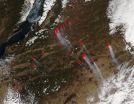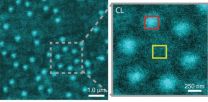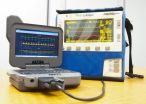(Press-News.org) LAWRENCE -- For centuries, people have imagined the possibility of life on Mars. But long-held dreams that Martians could be invaders of Earth, or little green men, or civilized superbeings, all have been undercut by missions to our neighboring planet that have, so far, uncovered no life at all.
Yet visits to the Red Planet by unmanned probes from NASA and the European Space Agency have found evidence that a prime condition for life once may have existed: water.
"There has been a tremendous amount of very exciting findings this year that Mars once contained actively flowing, low-saline, near-neutral-pH water -- pretty much the type of water where you find life on Earth today," said Alison Olcott Marshall, assistant professor of geology at the University of Kansas. "This has made people think that it's possible that life could have existed on Mars, although most researchers agree it's unlikely to exist today -- at least on the surface -- as conditions on the surface of Mars are incredibly harsh."
Olcott Marshall is working with her colleague and husband, Craig Marshall, associate professor of geology at KU, to improve the way scientists detect condensed aromatic carbon, thought to be a chemical signature of astrobiology.
"If we're going to identify life on Mars, it will likely be the fossil remnants of the chemicals once synthesized by life, and we hope our research helps strengthen the ability to evaluate the evidence collected on Mars," Craig Marshall said.
Craig Marshall is an expert in using Raman spectroscopy to look for carbonaceous materials, while Alison Olcott Marshall is a paleontologist interested in how the record of life gets preserved on Earth, especially when there is no bone or shell or tooth or other hard part to fossilize.
The pair is known recently for overturning the idea that 3.5 billion-year-old specks found in rocks in Australia were the oldest examples of life on Earth. (Rather than ancient bacteria fossils, the researchers showed the shapes were nothing more than tiny gaps in the rock that are packed with minerals.)
If traces if ancient biology are detected in Mars, the KU researchers want to make sure the evidence is more conclusive.
According to a recent paper by the Marshalls in the peer-reviewed Philosophical Transactions of the Royal Society, by itself Raman spectroscopy is able to screen for carbonaceous material, but it can't determine its source -- thus the technology needs to be supplemented in order to determine if life exists on Mars.
"Raman spectroscopy works by impinging a laser on a sample so the molecules within that sample vibrate at diagnostic frequencies," Craig Marshall said. "Measuring those frequencies allows the identification of inorganic and organic materials. It's insufficient because however the carbonaceous material is made, it will be the same chemically and structurally, and thus Raman spectroscopy cannot determine the origin."
The Marshalls call for the use of gas chromatography/mass spectroscopy to supplement Raman spectroscopy and develop more conclusive evidence of ancient extraterrestrial life.
"Much like the search for ancient life on Earth, though, one strand of evidence is not, and should not be, conclusive," said Alison Olcott Marshall. "This is a vast puzzle, and we want to make sure we are examining as many different pieces as we can."
Currently, the KU researchers are extending this line of investigation by using Raman spectroscopy to analyze rocks from Earth that are similar to those on Mars. They hope to publish their findings in the near future.
"If you were to pick up a typical rock on Mars it would look quite different, chemically, from a typical rock here on Earth, not to mention the fact that it would be covered in rusty dust," Alison Olcott Marshall said. "Previous research into how Raman spectroscopy would fare on Mars was mainly done on pure salts and minerals, often ones synthesized in a lab. We identified field sites on the Kansas-Oklahoma border with a chemical content more like what could be found on Mars, right down to the rusty dust, and we've been exploring how Raman spectroscopy fares in such an environment."
INFORMATION:
The Aqua satellite's MODIS (Moderate Resolution Imaging Spectroradiometer) instrument took this image of the fires in Siberia. The top image shows the full sized false color image of the area highlighting the burn scars from previous fires.
The sliding "before and after" image shows the real and false color images side-by-side for comparison. The left side shows current fires burning denoted by the red spots. These spots show areas where the thermal detectors on the MODIS instrument recognized temperatures higher than background. When accompanied by plumes of smoke, ...
Soft matter encompasses a broad swath of materials, including liquids, polymers, gels, foam and - most importantly - biomolecules. At the heart of soft materials, governing their overall properties and capabilities, are the interactions of nano-sized components. Observing the dynamics behind these interactions is critical to understanding key biological processes, such as protein crystallization and metabolism, and could help accelerate the development of important new technologies, such as artificial photosynthesis or high-efficiency photovoltaic cells. Observing these ...
DNA damage caused by smoking can be detected in cheek swabs, finds research published today in JAMA Oncology. The study provides evidence that smoking induces a general cancer program that is also present in cancers which aren't usually associated with it - including breast and gynaecological cancers.
The research team, led by Professor Martin Widschwendter, Head of the Department of Women's Cancer at the UCL Institute for Women's Health and Dr Andrew Teschendorff (UCL Cancer Institute) looked at epigenetic alterations - changes to the DNA that switch genes on and off. ...
May 14, 2015 - For medical practices, having more unique doctors on staff and having doctors see more patients doesn't necessarily lead to improved patient outcomes--and in fact, may have the opposite effect, according to a brief report in the June issue of Medical Care. The journal is published by Wolters Kluwer.
The study shows that high blood pressure (BP) is less likely to normalize during times when the number of unique doctors on staff is higher and more patients are seen, suggesting that "[W]hen practices are busier, BP care may suffer," writes Nancy R. Kressin, ...
Automated analysis of the vital signs commonly monitored in patients being transported to trauma centers could significantly improve the ability to diagnose those with life-threatening bleeding before they arrive at the hospital, potentially saving their lives. In the May issue of the journal Shock, a research team from Massachusetts General Hospital (MGH), the U.S. Army, air ambulance service Boston MedFlight, and two other Boston trauma centers report successful field testing of a system that simultaneously analyzed blood pressure, heart rate, and breathing patterns during ...
Scientists have made an important step towards understanding how volcanic eruptions happen, after identifying a previously unrecognised potential trigger.
An international team of researchers from the University of Liverpool, Monash University and the University of Newcastle (Australia) think their findings could lead to new ways of interpreting signs of volcanic unrest measured by satellites and surface observations.
Dr Janine Kavanagh, from the University of Liverpool's School of Environmental Sciences and lead author of the research paper, said: "Understanding the ...
Led by Georgia State University, researchers have developed the first robust and noninvasive detection of early stage liver cancer and liver metastases, in addition to other liver diseases, such as cirrhosis and liver fibrosis.
Their findings were published Wednesday (May 13) in Proceedings of the National Academy of Sciences.
More than 700,000 people are diagnosed with liver cancer each year. It is the leading cause of cancer deaths worldwide, accounting for more than 600,000 deaths annually, according to the American Cancer Society. The rate of liver cancer in the ...
The combination of a cholesterol-lowering drug, Bezafibrate, and a contraceptive steroid, Medroxyprogesterone Acetate, could be an effective, non-toxic treatment for a range of cancers, researchers at the University of Birmingham have found.
The findings published in the journal Cancer Research show that the drugs kill cancer cells in a completely new way.
Early stage clinical trials of the drugs in elderly patients with acute myeloid leukaemia (AML) have shown promising results, with survival three months longer on average than standard palliative care. The combination, ...
Alexandria, VA - The evolutionary age of grass has been hotly contested. Scientists have previously dated the earliest grasses to 55 million years ago; after the dinosaurs went extinct. Now, a new 100-million-year-old specimen of amber from Myanmar potentially pushes back grass evolution to the Late Cretaceous.
Scientists from the Oregon State University who studied the amber believe they identified "spikelet" - grass in its flowering state - and a cluster of fossilized ergot, a major ingredient in LSD. While their conclusions are intriguing, and have implications for ...
The knock-on effects of the economic downturn have been explored in economy and psychology. Now researchers are examining the effects of unemployment on an even darker subject - cancer mortality.
One would think that dealing with unemployment was challenge enough. But according to the latest research published in ecancermedicalscience, rises in unemployment are associated with significant increases in prostate cancer mortality.
This is the first study that has systematically explored the consequences that changes in unemployment - in particular the Great Recession ...


